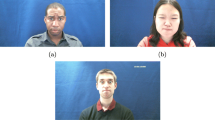Abstract
Facial expressions contain most of the information on human face which is essential for human–computer interaction. Development of robust algorithms for automatic recognition of facial expressions with high recognition rates has been a challenge for the last 10 years. In this paper, we propose a novel feature selection procedure which recognizes basic facial expressions with high recognition rates by utilizing three-Dimensional (3D) geometrical facial feature positions. The paper presents a system of classifying expressions in one of the six basic emotional categories which are anger, disgust, fear, happiness, sadness, and surprise. The paper contributes on feature selections for each expression independently and achieves high recognition rates with the proposed geometric facial features selected for each expression. The novel feature selection procedure is entropy based, and it is employed independently for each of the six basic expressions. The system’s performance is evaluated using the 3D facial expression database, BU-3DFE. Experimental results show that the proposed method outperforms the latest methods reported in the literature.








Similar content being viewed by others
References
Ekman, P., Friesen, W.: The Facial Action Coding System: A Technique for the Measurement of Facial Movement. Consulting Psychologists Press, San Francisco (1978)
Abrantes, G., Pereira, F.: MPEG-4 facial animation technology: survey, implementation and results. IEEE Trans. Circuits Syst. Video Technol. 9(2), 290–305 (1999)
Darwin, C.: The expression of the emotions in man and animals, 2nd edn. In: Darwin, F. (ed.) J. Murray, London (1904)
Ekman, P., Friesen, W.: Pictures of Facial Affect. Consulting Psychologist Press, Palo Alto, CA (1976)
Waters, K.: A muscle model for animation three-dimensional facial expression. ACM Comput. Graph. (Proc. SIGGRAPH) 21(4), 17–24 (1987)
Parke, F., Waters, K.: Computer Facial Animation. AK Peters, Wellesley, MA (1996)
Pandzic, I.S., Forchheimer, R.: MPEG-4 Facial Animation: The Standard, Implementation and Applications. Wiley, London (2002)
Cowie, R., Douglas-Cowie, E., Karpouzis, K., Caridakis, G., Wallace, M., Kollias, S.: Recognition of emotional states in natural human–computer interaction. In: Multimodal User Interfaces. Springer, Berlin Heidelberg (2008)
Yurtkan, K., Soyel, H., Demirel, H., Özkaramanlı, H., Uyguroğlu, M., Varoğlu, E.: Face modeling and adaptive texture mapping for model based video coding. LNCS 3691, 498–505 (2005)
Patel, N., Zaveri, M.: 3D facial model reconstruction, expressions synthesis and animation using single frontal face image. Signal Image Video Process. 7(5), 889–897 (2011)
Lajevardi, S.M., Hussain, Z.M.: Automatic facial expression recognition: feature extraction and selection. Signal Image Video Process. 6(1), 159–169 (2012)
Buciu, I., Kotropoulos, C., Pitas, I.: Comparison of ICA approaches for facial expression recognition. Signal Image Video Process. 3(4), 345–361 (2009)
Tian, Y., Kanade, T., Cohn, J.: Recognizing action units for facial expression analysis. IEEE Trans. Pattern Anal. Mach. Intell. 23(2), 97–115 (2001)
Bourel, F., Chibelushi C.C., Low, A.A.: Recognition of facial expressions in the presence of occlusion. In: Proceedings of the 12th British Machine Vision Conference, vol. 1, pp. 213–222 (2001)
Cohen, I., Sebe, N., Garg, A., Chen, L.S., Huang, T.S.: Facial expression recognition from video sequences: temporal and static modeling. Comput. Vis. Image Underst. 91, 160–187 (2003)
Pantic, M., Patras, I.: Dynamics of facial expression: recognition of facial actions and their temporal segments form face profile image sequences. IEEE Trans. Syst. Man Cybern. Part B 36(2), 433–449 (2006)
Wang, J., Yin, L.: Static topographic modeling for facial expression recognition and analysis. Comput. Vis. Image Underst. 108, 19–34 (2007)
Kotsia, I., Buciu, I., Pitas, I.: An analysis of facial expression recognition under partial facial image occlusion. Image Vis. Comput. 26(7), 1052–1067 (2008)
Lyons, M., Budynek, J., Akamatsu, S.: Automatic classification of single facial images. IEEE Trans. PAMI 21, 1357–1362 (1999)
Wang, J., Yin, L., Wei, X., Sun, Y.: 3D facial expression recognition based on primitive surface feature distribution. In: Proceedings of the IEEE International Conference on Computer Vision and Pattern Recognition, vol. 2, pp. 1399–1406 (2006)
Soyel, H., Tekguc, U., Demirel, H.: Application of NSGA-II to feature selection for facial expression recognition. Comput. Electr. Eng., Elsevier 37(6), 1232–1240 (2011)
Soyel, H., Demirel, H.: Localized discriminative scale invariant feature transform based facial expression recognition. Comput. Electr. Eng. 38(5), 1299–1309 (2012)
Ebrahimi, N., Soofi, E.S., Slottje, D.J. (eds.): Measuring informativeness by entropy and variance. Advances in Econometrics, Income Distribution, and Methodology of Science (Essays in Honor of Camilo Dagum). Springer, Berlin (1999)
Maji, S., Berg, A.C., Malik, J.: Classification using intersection kernel support vector machines is efficient. In: IEEE Computer Vision and Pattern Recognition Conference, CVPR (2008)
Frenken, K.: Entropy statistics and information theory. In: Hanusch, H., Pyka, A. (eds.), The Elgar Companion to Neo-Schumpeterian Economics, pp. 544–555. Edward Elgar, Cheltenham, UK and Northampton MA (2007)
Yin, L., Wei, X., Sun, Y., Wang, J., Rosato, M.: A 3D facial expression database for facial behavior research. In: Proceedings of International Conference on FGR, pp. 211–216, UK (2006)
Mpiperis, I., Malassiotis, S., Strintzis, M.G.: Bilinear models for 3D face and facial expression recognition. IEEE Trans. Inf. Forensics Secur. 3(3), 498–511 (2008)
Tang, H., Huang, T.S.: 3D facial expression recognition based on properties of line segments connecting facial feature points. In: Proceedings of the IEEE International Conference on Automatic Face and Gesture Recognition, pp. 1–6 (2008)
Erol, F., Güdükbay, U.: An interactive facial animation system. In: The 9th International Conference in Central Europe on Computer Graphics, Visualization and Interactive Digital Media (WSCG’2001), Poster Proceedings, pp. P5–P8, Plzen–Bory, Czech Republic, Feb 7–10 (2001)
Author information
Authors and Affiliations
Corresponding author
Rights and permissions
About this article
Cite this article
Yurtkan, K., Demirel, H. Entropy-based feature selection for improved 3D facial expression recognition. SIViP 8, 267–277 (2014). https://doi.org/10.1007/s11760-013-0543-1
Received:
Revised:
Accepted:
Published:
Issue Date:
DOI: https://doi.org/10.1007/s11760-013-0543-1




